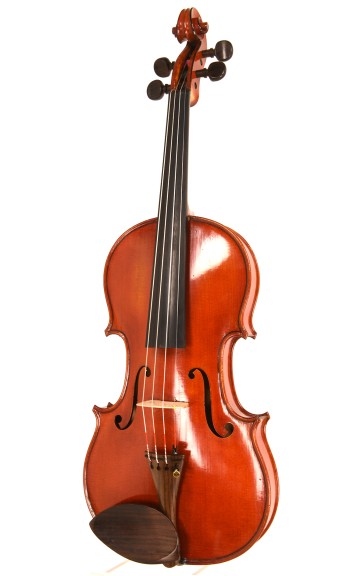Pierre Hel - a guiding light in modern French violin making of the early 20th century
Pierre Hel's apprenticeship and first work years
When Pierre Hel's father Joseph died in the year 1902, he left his son a well-established studio and the good name he had created for himself amongst leading musicians of his day. Carrying this mantle must have been a special challenge for the young master Pierre Hel (b. 1884), who had returned to his parents' home shortly before his father's death. After the apprenticeship he is thought to have completed under Gustave Bazin (1871-1920) in Mirecourt - one of the few Bazins who became a violin maker - Pierre Hel had only little time to broaden his mastery of the family trade. In the first years after his father's death, Pierre strictly followed the classic Italian role models, and his Amati, Stradivari and Guarneri replicas of this period confirm the young master's outstanding talent and early sense of perfection. This phase of his work meant more than finding a steady way of earning a living or pursuing a grand tour across the roots of European violin making, however. And the fact that Pierre Hel used the eye-catching deep-red varnish which his father had developed is only one of the more striking ways in which the relevance of this period can be seen. Neither Joseph nor Pierre Hel were ever mere epigones of the Cremonese; instead, they were modern violin makers working at the height of their time and who were unmistakably at home in the French tradition of their art.
Content overview:
- Apprenticeship and first years
- First success
- Pierre Hel's cooperation with great contemporary soloists
- Successors of Pierre Hel
First success of French violin maker Pierre Hel
Pierre Hel's first major successes occurred quickly, and they must have given him the affirmation that his approach was correct. In 1900, while Joseph Hel was still alive, Pierre won his first prize in Paris, soon to be followed by other awards in 1904 in St. Louis, Missouri and 1906 in Milan. These honours allowed him to build on his father's international reputation. As a violin maker at the conservatory in Lille (another task where he followed in his father's footsteps) and the Conservatoire Royal de La Haye (Den Haag), Pierre made a good living for himself, while at the same time maintaining ongoing contact with musicians in a manner that benefited his stylistic development.
Pierre Hel's cooperation with great contemporary soloists
Pierre Hel designed the “Stradivarius Moderne” series especially to meet the demands of young soloists, an endeavour which can be seen as his first major independent success. His excellent-quality instruments generated strong demand which prompted Pierre Hel to outsource their production starting in 1919 – a commission that was given to no less a luminary than his great contemporary Léon Victor Mougenot. With the additional time Pierre gained by delegating this task, he had greater opportunities to work on a more independent basis from 1920 onward. His instruments won over growing numbers of the major soloists of his generation. Pierre Hel's solid reputation was cemented by the enthusiastic reviews that Rumanian soloist, composer and conductor George Enescu (1881-1955) garnered on his US tour in 1923, during which he performed on a Pierre Hel violin. This boost to his standing helped Pierre's name grow to equal that of his father. As a result, the second phase in Pierre Hel's work, which lasted until his death in 1937, is considered his most creative and productive period. In these years he was also successful as a merchant of historic stringed instruments and a craftsman of top-quality bows.
Successors of Pierre Hel
The impact he left on European violin making through his students and employees may have been limited but was certainly distinctive; his "heirs" included Desmond D’Artrey Hill, who managed the traditional London-based atelier W. E. Hill & Sons through the second half of the 20th century. Hel's atelier continued operations after his death until the year 1943 under the leadership of his widow and Marcel Demey, one of the employees who had worked alongside Pierre Hel from the very beginning and remained at his atelier for over 40 years.
Related articles:
Nicolas Lupot - the second great name in French violin making
The Concours Etienne Vatelot, Paris
Le Canu-Millant: Le Canu-Millant, Paris: lutherie and expertise
Vatelot-Rampal: on the art of healing violins
Beares and J & A Beare, London : Expertise in changing times
Eugène Nicolas Sartory: the modern classic of bow making
Bazin's grandchildren: bow making in turbulent times
François Xavier Tourte, founding father of the modern violin bow




